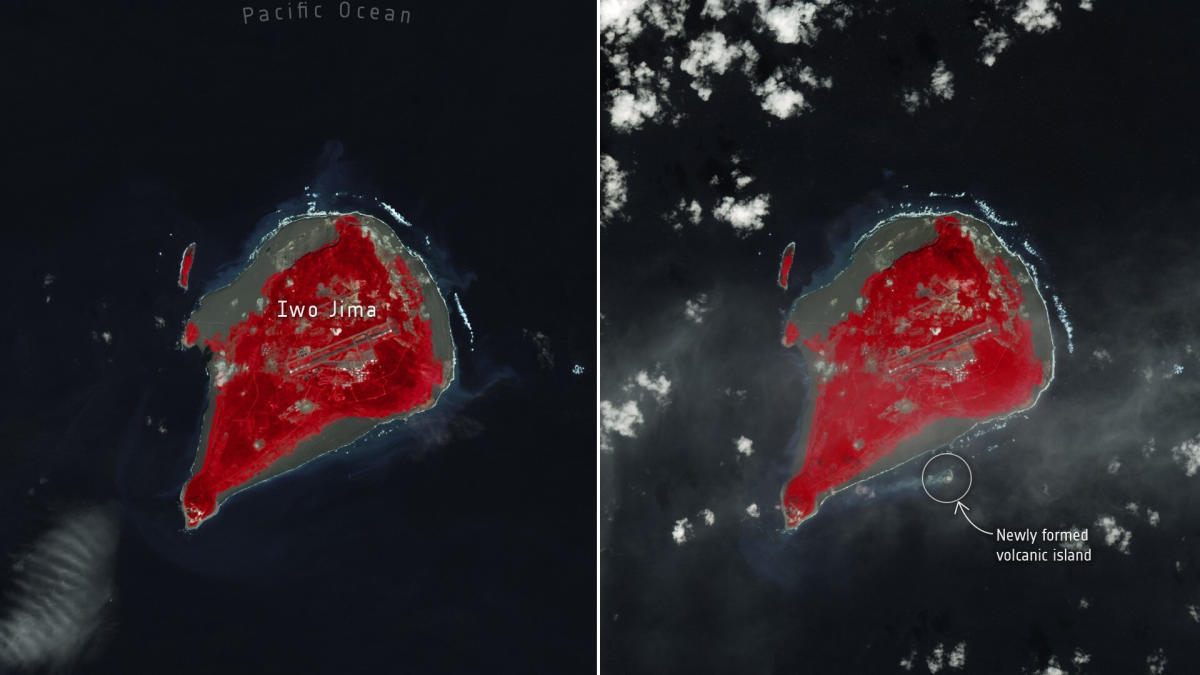A NASA satellite has spotted a newly formed island off the coast of Japan that experienced a fiery birth at the end of October.
The joint NASA/U.S. Geological Survey satellite Landsat-9 saw the island rise from the sea off the coast of Iwo Jima island, part of the Volcano Islands archipelago in south Japan, on Nov. 3.
The island was born 750 miles (1,200 kilometers) south of Tokyo between 12:20 and 12:35 local time on Oct. 30 when blisteringly hot magma fell into the ocean and exploded, creating chunks of rock several feet long more than 160 feet (50 meters) into the air, according to the University of Tokyo.
“According to the Japan Meteorological Agency, the eruption appears to have started on October 21, 2023,” University of Tokyo researchers wrote. “The location of this eruption is almost the same as the 2022 eruption location and is thought to indicate the resumption of magma activity on Iwo Jima.”
Related: See Artemis 2 astronauts explore moon-like crater in Canada (photos)
The underwater eruptions broke the ocean’s surface at two locations in the form of explosions at the southern tip of Iwo Jima, and rocks gathered to the north of these explosions. This growing rubble pile eventually formed a 330-foot (100-meter) wide island, around half a mile (1 kilometer) from Iwo Jima, sat in discolored water littered with very porous rock called pumice.
An extremely light rock, pumice is created when lava with a very high content of water and gases is discharged from a volcano. As gas bubbles escape this lava, it becomes “frothy,” cooling and hardening into a bubble-filled rock.
Landsat-9 saw the island from its position 438 miles (705 kilometers) above Earth on Nov. 3, and this image was compared to observations of the region collected by the same satellite on Oct. 18 in which the island was not present.
RELATED STORIES:
— A satellite’s very tiny camera took a very blurry picture of Earth — and it’s perfect
— Scientists finally discover ‘lost continent’ thought to have vanished without a trace
— NASA’s SWOT satellite maps nearly of all Earth’s water (video)
The birth of the island was witnessed by a craft much closer to home when an aircraft owned by Mainichi Shimbun, a Japanese newspaper, was the initial stages of an underwater eruption in the southern part of the Izu-Ogasawara arc — an oceanic trench in the western Pacific Ocean.
The site of the new island has been a hotbed of underwater eruptions of steam and lava over recent years, University of Toyko researchers said, adding that this is one of the fastest-rising caldera volcanoes — a large depression formed when a volcano erupts and collapses — in the world.

Dr. Sarah Adams is a scientist and science communicator who makes complex topics accessible to all. Her articles explore breakthroughs in various scientific disciplines, from space exploration to cutting-edge research.






